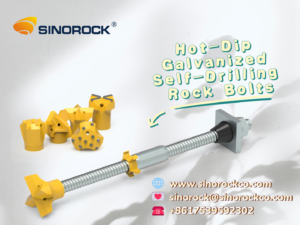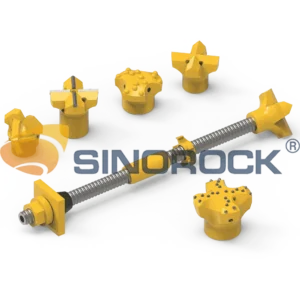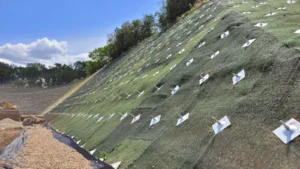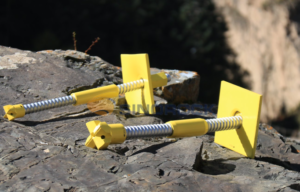In the field of geotechnical engineering, self-drilling rock bolts have gained widespread adoption for a range of projects, including stabilizing slopes, reinforcing foundation pits, and fortifying tunnels. These systems, primarily made from steel, are highly effective due to their dual functionality as both drill rods and anchor rods. However, despite their versatile design and critical importance in construction, self-drilling rock bolts are particularly susceptible to corrosion, which can compromise the integrity and longevity of these systems. Effective anti-corrosion measures are therefore essential to ensure the durability and safety of self-drilling rock bolts in various environments.
Understanding Self-Drilling Rock Bolts
Self-drilling rock bolts are an advanced anchoring solution used in challenging ground conditions where traditional drilling and anchoring methods are insufficient. These bolts are designed to simultaneously drill into the ground and anchor the structure, streamlining the installation process. Their hollow design allows for grout injection through the rod body, which stabilizes the surrounding soil or rock and provides additional reinforcement.
This all-in-one functionality—combining drilling, grouting, and anchoring—makes self-drilling rock bolts highly efficient and ideal for numerous geotechnical applications, such as slope stabilization, tunnel reinforcement, and deep foundation support. However, given that these systems are predominantly composed of steel, they are at risk of corrosion, especially when exposed to harsh environmental conditions.
The Importance of Corrosion Prevention
Corrosion poses a significant threat to the structural integrity of steel-based systems like self-drilling rock bolts. When steel is exposed to moisture, oxygen, and other environmental factors such as salts or acids, it can undergo chemical reactions that weaken its structure. Over time, corrosion can lead to reduced load-bearing capacity, structural failures, and even catastrophic project failures.
In geotechnical applications, the safety and stability of infrastructure heavily depend on the performance of self-drilling rock bolts. Consequently, implementing effective corrosion prevention strategies is crucial not only for extending the service life of these systems but also for ensuring the safety and stability of the overall project. Without proper anti-corrosion measures, the performance of self-drilling rock bolts could degrade, leading to costly repairs or replacements and, more importantly, putting public safety at risk.
Common Anti-Corrosion Techniques for Self-Drilling Rock Bolts
Several effective anti-corrosion techniques are commonly employed in the industry to protect self-drilling rock bolts from corrosion. These techniques are essential in ensuring that the bolts maintain their structural integrity over time, even when exposed to corrosive environments. Below are two widely used methods:
Epoxy Coating Application
Epoxy coatings are among the most common and effective methods for preventing corrosion in self-drilling rock bolts. An epoxy coating is applied to the surface of the steel components, creating a durable barrier that shields the material from corrosive elements like moisture, chlorides, and sulfides. This coating is particularly effective in environments where corrosive agents are prevalent, such as coastal areas or industrial sites with high concentrations of chemical pollutants.
By forming a protective layer, the epoxy coating prevents direct contact between the steel and external corrosive factors. This significantly enhances the lifespan of the rock bolts, ensuring that they remain structurally sound and continue to perform their function in geotechnical applications. In addition to providing corrosion protection, epoxy coatings also enhance the mechanical properties of the bolts, such as resistance to wear and abrasion, which further contributes to their durability.
Hot-Dip Galvanizing
Hot-dip galvanizing is another widely used method for protecting self-drilling rock bolts from corrosion. In this process, the steel components are immersed in molten zinc, which forms a protective coating on the surface of the steel. The zinc coating acts as a sacrificial layer, meaning that it will corrode before the steel does, thereby delaying the onset of corrosion in the steel itself.

Hot-dip galvanizing is especially effective in environments characterized by high levels of moisture or chemical exposure, such as marine or industrial settings. The zinc coating provides a strong barrier against corrosion, ensuring that the self-drilling rock bolts maintain their structural integrity over time. Additionally, the galvanizing process is known for its durability, with galvanized steel often lasting for decades without significant corrosion.
This technique is particularly useful in environments where exposure to acidic or alkaline conditions is expected, as the zinc coating offers superior protection compared to other types of coatings. In many cases, hot-dip galvanizing can extend the life of self-drilling rock bolts well beyond the expected lifespan of uncoated or lesser-protected systems.
Best Practices for Corrosion Prevention in Engineering
While anti-corrosion coatings and treatments are critical in protecting self-drilling rock bolts, their effectiveness largely depends on proper implementation during engineering practice. Failure to apply coatings correctly or adhere to industry standards can reduce the protective capabilities of these methods, leaving the system vulnerable to corrosion.
Ensuring the long-term performance of self-drilling rock bolts requires strict adherence to construction protocols, including proper surface preparation before applying coatings and ensuring that all components, such as couplers and drill bits, receive appropriate protection. Regular inspections should also be conducted to identify any signs of coating degradation or corrosion and to take corrective actions before significant damage occurs.
Furthermore, the selection of corrosion prevention methods should be tailored to the specific environmental conditions of the project site. For example, projects located in coastal regions may require more robust protection, such as a combination of epoxy coatings and hot-dip galvanizing, to address the heightened risk of corrosion due to saltwater exposure.
Conclusion
Preventing corrosion in self-drilling rock bolts is essential to ensuring the long-term stability, safety, and performance of geotechnical projects. By employing proven anti-corrosion techniques such as epoxy coating and hot-dip galvanizing, and adhering to best practices in construction and maintenance, the lifespan of these critical support systems can be significantly extended.
As the industry continues to evolve, new innovations in materials, coatings, and monitoring technologies will further enhance the ability to protect self-drilling rock bolts from corrosion, ensuring their reliability in even the most challenging environments. Through diligent corrosion prevention efforts, practitioners can safeguard the integrity of their projects, protect public safety, and reduce long-term maintenance costs.





